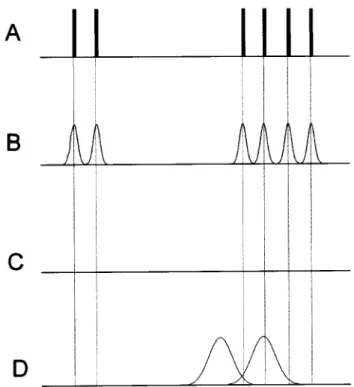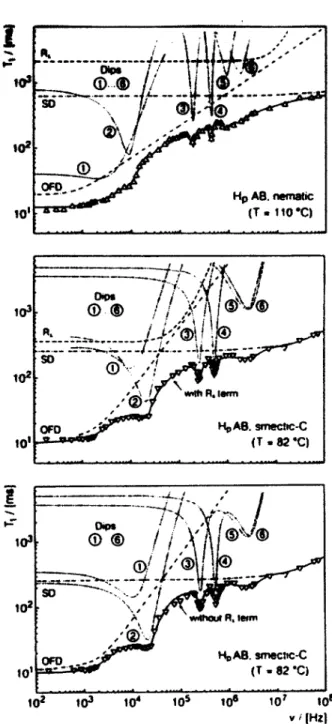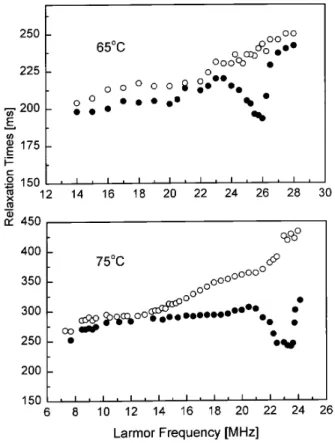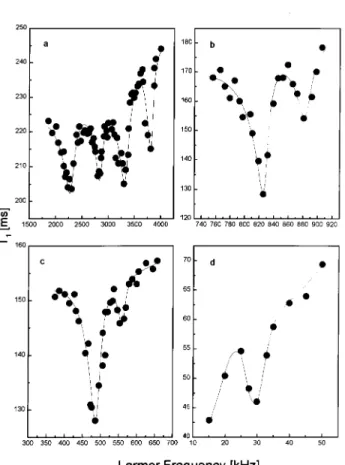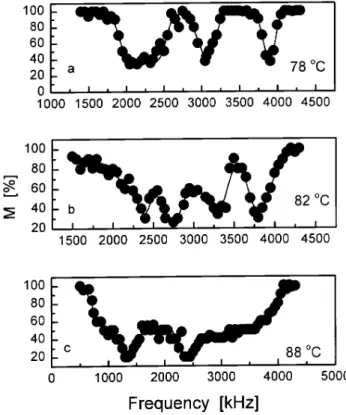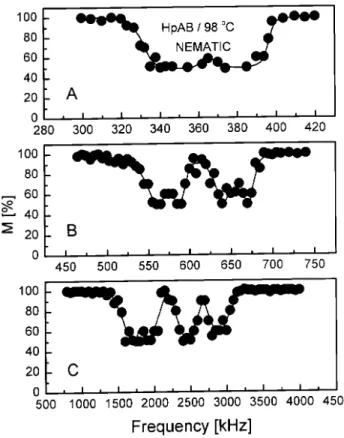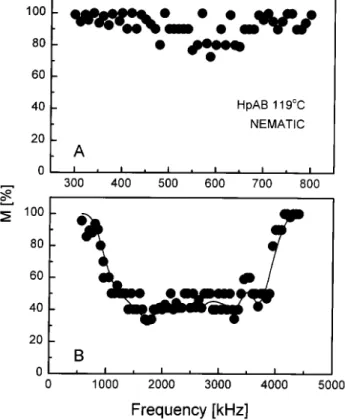Molecular Microstructure in Thermotropic Liquid
Crystals Studied by Nuclear Quadrupole
Resonance Spectroscopy
Daniel J.Pusiol and EstebanAnoardoFacultad de Matematica, Astronoma y Fsica, Universidad Nacional de Cordoba, Ciudad Universitaria, 5000 Cordoba, Argentina
Received29October,1998
Nuclear Quadrupole Resonance studies in Nematic and Smectic C thermotropic liquid crys-talline mesophases of p-heptyl azoxyanizole are reported. The local molecular microstructure is modeled from NQR spectra. In the Smectic C mesophase, the NQR data is explained by assuming two features: i) biaxiality in the electric eld gradients at the sites occupied by14
N nuclei, and ii) the elemental unit cell of the mesophase is composed by two HpAB molecules. These bimolecular units coexist together with single molecules and the relative proportions change with temperature, the quantity of individual molecules being predominant as the temperature approaches the Nematic phase transition. At the lowest temperatures in the Nematic mesophase the NQR spectrum behaves similarly to the corresponding at low tem-peratures in the SmC mesophase; this means that we can propose again the existence of a huge number of bimolecular and biaxial unit cells. At higher temperatures the transition to single molecular units is deduced from NQR spectra. That transition is characterized by the one describing the passage from a partially disordered molecular system -the system is conserving some local anisotropic properties of symmetry from the crystalline solid state- to a partially ordered system that resembles an oriented liquid.
I Introduction
From the discovery of liquid crystals (LCs) one hundred and ten years ago, a lot of progress has been achieved in the synthesis and in characterization of macroscopic properties. In addition, we can observe very interest-ing and diverse applications in high technological con-suming devices. However, few groups are investigat-ing microscopic molecular arrangements and dynamics, specially in the slow motions time scale. As it is an important physical tool, in this paper we summarize recent advances in understanding molecular local order-ing in nematic (N) and smectic (Sm) liquid crystalline mesophases, which can be used to design technologi-cally applicable materials.
The experimental technique we select for our present study is the Nuclear Quadrupole Resonance, NQR. From last years NQR has been established to
be a powerful tool to study local molecular order in crystalline as well as in partially disordered solids [1-5]. power of the technique has been extensively tested in many studies as, for instance, weak distortions and slow dynamical pretransitional eects near a second or-der phase transitions [6], the determination of thermally activated vacancies in molecular solids [7], etc.
From the rst NQR experiments in liquid crystals, it has been established the utility of the technique to study local molecular ordering properties [8, 9]. The main advantage is due to the easy identication of NQR nuclei spectra in comparison with the always com-plex proton Nuclear Magnetic Resonance NMR spectral information. Conventional NQR experiments in LC-mesophases have been up to now unsuccessful, mainly by two facts:
even in simplest low molecular weight LCs; and, 2. the relatively strong molecular uctuations
aver-age of the electric eld gradients EFGs at the ob-served NQR-active nuclear sites.
However, NQR spectra have been measured via two similar proton Zeeman-quadrupole cross relaxation techniques; i.e.,
1. crossover relaxation in the laboratory frame at a xed relaxation period COR [8]; and,
2. from quadrupole dips (QDs), observed in the spin-lattice relaxometry proles [10, 11, 12].
In both techniques the Zeeman magnetic eld is scanned over enough range, in order to overlap both quadrupole and Zeeman spin systems. Consequently, the NQR spectra reconstructed QDs as well as COR minima are distorted by the Zeeman eld. In solids, un-perturbed NQR spectra can be alternatively recorded from zero-magnetic eld Nuclear Quadrupole Double Resonance NQDOR technique [13]. The experiments involve both Field Cycling NMR of protons -from high to zero magnetic eld-, together with the irradiation of the quadrupole 14
N nuclei by means of a second radiofrequency, just during the period of zero Zeeman magnetic eld.
In order to describe the advances in the study of molecular microstructures by NQR, we organize this paper as follows:
1. An introduction to NQR technique fundaments is described in the next section making reference to spinI = 1 quadrupole spectra predicted for:
(a) crystalline solids,
(b) partially disordered solids, (c) isotropic liquids, and (d) oriented liquids.
2. Some previous experimental results, the QDs ex-perimental set-up together with some recent im-provements are shown in the third section. 3. Experimental measurements carried out in the
smectic C (SmC) mesophase of p-heptyl azoxy-benzene (HpAB) are analyzed assuming a local molecular self-organization whose basic cell is bi-molecular.
4. In the fth section a brief reference to the NQ-DOR technique and its experimental set-up is given.
5. The experimental behaviors of NQDOR spectra at several temperatures in both the SmC and ne-matic N mesophases of HpAB are described in the following section. The compatibility of NQ-DOR spectral data with those from the previous QDs experiments is analyzed in SmC-HpAB. At low temperatures in the N-phase NQDOR spec-tra can be interpreted by proposing local EFG biaxiality at the14
N nuclei sites. At higher tem-peratures, always within the N-phase range, the transition to a uniaxial EFG symmetry can be deduced from our NQDOR experiments.
6. A brief summary is added at the last section.
II NQR fundamentals and
spec-tra
The rst non-zero anisotropic expansion term of the electric energy is used to describe the interaction be-tween two electric charge distributions: one the nuclear and the other composed by all the electric charges out-side the volume occupied by the quadrupolar nucleus. In fact, for our purposes we can reduce ourself to rep-resent that nuclear interactions through the interaction energy of the nuclear quadrupole moment tensorQand the electric eld gradient tensorV valuated at the site occupied by the resonant quadrupole nucleus. There-fore, the NQR HamiltonianH
Qis the product
QandV tensors. The NQR spectrum for a singleI = 1 nucleus (for instance,14
N or deuterium 2
H) is constituted by three lines: a high frequency doublet -for14
N it is lo-cated generally in the megahertz frequency scale-, and a single resonance situated in the kHz's for the same nucleus. If the z-direction of the principal reference system is dened in the direction of the maximum com-ponent of V (V
zz =
q), the three resonance lines are related with the quadrupole coupling constant and the asymmetry parameter by the expressions:
=
o = (1
=3);
=
e 2
qQ ~ and
= ( V
xx ,V
yy) V
zz ;
whereeis the electron charge,Qis the quadrupole mo-ment of the nucleus and~ is the Planck's constant.
Note that describe the departure of V from the cylindrical geometry and it is, in consequence a measure of the EFG biaxiality. We should to point out here too that the quantization axis is dened by the direction of V
zz; therefore, the biaxiality is also referred to the two axes which are perpendiculars to that direction. That reference system is mounted on the studied molecule.
As it is shown in Fig. 1,HpAB molecule possesses two14
N nuclei. The two nuclei could be unequivalent, or in other words they sense dierent's and's at its respective positions.
In the case of a crystalline solid with a molecu-lar structure like the one described in Fig. 1, we can expect in general a NQR spectrum composed by six quadrupole lines, see Fig. 2a and refs. [10, 11, 1, 14]. Even more, there are a large quantity of solids with unit cells constructed with two unequivalent molecules. A complex twelve resonances spectrum (three lines for each of the unequivalent 14
N is predicted for such a case. Coming back to the unimolecular unit cell ample, but introducing some local disorder we can ex-pect a broadening of the NQR lines produced by lo-cal dispersion of both and ; see Fig. 2b. In the case of a spherically symmetric EFG, where the spa-cial anisotropy of V disappears by the random molec-ular averaging, the NQR lines completely disappears, see Fig. 2c; i.e., the case of a isotropic liquid. Finally we will consider the case of an oriented liquid; as it is a "rod-like" nematic liquid crystal. There are in this case fast rotations of the LC molecule following the long axis, averaging the EFG asymmetry.. In consequence, the EFG at the quadrupole nucleus position is being uniaxial. See in Fig. 2d the expected NQR spectrum schematically drawled.
Figure 1. The HpAB molecular structure. Nitrogens N 1
and N
2 sense in general each one dierent values of and :
1 ;
2 ;
1 and
2.
Figure 2. Schematic representation of the NQR spectrum expected for a molecule like theHpAB-with two
unequiv-alent 14
N nuclei, in the following situations: a) a single
molecular unit cell; b)the same as in a), but with the
in-troduction of parcial disorder;c)an isotropic liquid andd)
a molecular oriented liquid.
III NQR spectrum from
T1()-prole dips
IIII QDs experimental procedure
The phenomenon known as QDs is due to a resonant ef-fect occurring when the Zeeman levels of a spin specie (protons 1
H in our case) and the Zeeman-perturbed quadrupolar spin system (14
principally through electric interactions, and in addi-tion both are externally compelled to couple between them through the dipole-dipole magnetic interaction. As compared with protons, quadrupolar nuclei are in general strongly coupled to the lattice and their spin-lattice relaxation rate is thus much faster. If the level-crossing condition has been reached by the experimen-tal arrangement, a net ow of energy takes place from protons to quadrupolar nuclei and then to the lattice. The measurable consequence of this resonant process is an increment in the proton relaxation rate just at the Larmor frequencies of1
Hwhich are coincident with the 14
N-NQR resonances. Measuring the spin-lattice relax-ation timeT
1of protons at Larmor frequencies scanned over a broad range, the 14
N spectrum is thus recorded through thedipsobserved in theT
1(
L)-prole. A com-prehensive analysis of the14
N -1
Henergy exchanges and involved relaxation processes at various 1
H-NMR and 14
N-NQR overlapping spectra situations, together with applications in some living systems, are given in refs. [15] and [16].
The experimental set-up is home made [17], the design is based in the Electronically Switched Fast Field Cycling NMR spectrometer, rst developed at the Noack's Laboratory -Stuttgart- [18], which use a special air core magnet design [19] and a MOSFETs magnet control and power switching [20].
IIIII First experimental results
The rsts NQR studies in liquid crystals where carried out ten years ago [10, 11]. Fig. 3 shows respectively the cases ofHpAB in the SmC and N mesophases at T = 78, 82 and 110oC. Extensions to other thermotropic liq-uid crystals, having only one14
Nin its molecular struc-ture, are shown in Fig. 4. In all the compounds and mesophases, the spectra are more similar to that of Fig. 2b (dispersed anisotropic EFGs) than that of Fig. 2d (characteristics of "rod-like" LCs).
The nucleus of Chlorine presents a quadrupole mo-ment approximately one order of magnitude higher than14
N, therefore QDs can be expected in the tenth MHz regime. In order to check if QDs are a phe-nomenon itself or simply an eect on T
1(
L) produced by cycling the Zeeman eld, studies involving 1
Hand 35
ClQDs were performed in a chlorinated LC by means of the conventional NMR technique, without the use of Field Cycling [12]. In addition, it was possible to sep-arate the T
1-prole from the molecular chain and core
protons. Dips on theT 1(
L) of protons neighboring the 35
Clnucleus (belonging to the molecular core) are, or course, more deply (see Fig. 5 ).
Figure 3. QDs obtained at the F. Noack's Laboratory, Stuttgart, inHpAB. A high Larmor frequencies unresolved
Figure 4. T1(L) proles obtained in a LC with a single
ni-trogen atom in the molecule (8CB). A high frequency dou-blet and a singlete at the left of the relaxometry prole is observed in both mesophases. The three NQR lines indicate again biaxially EFG tensor at the single 14
Nsite. See ref.
[10] for details. QDs are absent in the isotropic phase.
Figure 5. a) Experimental results of the spin-lattice re-laxation times at T = 65
o
C and T = 75 o
C. Empty
cir-cles represents the Larmor frequency behaviour of T alk yl
1 .
Quadrupole dips are clearly distinguished in theT a,c 1
be-haviour (lled circles).
After that rst studies, narrow QDs were measured by Dvinskikh and Molchanov [24] in ethoxybenziden-butylanilin EBBA and by Zolino [21] in p-azoxyanizole PAA. More recently we worked out extensive rene-ments in the experimental technique in order to care-fully control those parameters of the experiment which broad the spectral distribution of QDs: i.e.,i)the sta-bility and precision of the Zeeman eld during the level crossing period;ii)the temperature gradients along the sample volume; and iii)the purity of the sample. See refs. [22] and [23] for details.
IV QDs measurements in
SmC-HpAB
In Fig. 6 we depict the T 1(
L) of
SmC-HpAB at T = 82 oC measurements, within the spectral regions where QDs were detected. NineT
1(
L) QDs have been found!: a low frequencies single dip at
L
30 kHz; two high frequencies doublets at 500 and 800 kHz and a higher frequencies quadruplet. This rich in peaks spec-tral structure can only be explained by assuming more than two chemically unequivalent nitrogen nuclei capa-ble to contribute to the protons spin-lattice relaxation dispersion. Note that what we have done here was merely to resolve an internal structure in the T
1(
L) proles previously studied [10]. At this altitude we can assign -within a certain degree of safety- the relaxom-etry spectrum to a bimolecular unit cell in the SmC-HpAB mesophase [22], where one of the nitrogens of a molecule is not equivalent with its pair of the part-ner one in the elemental unit cell. See Fig. 7 where we schematize the possible situation. There are two equivalent nuclei, one of each molecule, for instanceN
2 and N
4. Following the molecular structure of
HpAB, we can assume that the electronic charge of the oxygen atom provokes higher andat the N
1 nuclear posi-tions -one in each molecule-. We will discuss again the assignment of QDs together with pure NQR spectrum acquired with the double resonance technique. In this case we can conclude that three unequivalent nitrogens from the two molecules having biaxial EFGs can pro-duce the observed nine QDs in theT
1(
when the crystalline-SmC phase transition takes place, the inter-unit cell forces rather vanishes, but the ther-mal agitation is not enough to average the bonding force in between the two molecules of the unit cell.
Figure 6. Experimental QDs in the T1(L) -prole,
mea-sured in SmC-HpABat T = 82
oC. We can compute nine
QDs in theL range from 1 kHz to 4 MHz. In the gure
only theT 1(
L) -proles in the interes range are represented.
Two unequivalentHpABmolecules form the elementary
mi-croscopic units of the LC mesophase, see text.
For a description from a referential system mounted on the proper molecule, as the present is, the elec-tric eld gradients of every one of the four nitrogens involved in the LC-bimolecular unit cell are biaxial. We conclude theseT
1(
L) prole studies classifying the SmC mesophase of HpAB as a partially disordered molecular system.
Figure 7. Schematic molecular arrangement proposed for the elementary unit cell of SmC-HpAB.
V Nuclear Quadrupole Double
Resonance
As in the case of the above described QDs in the relax-ometry prole technique, the NMR of protons is used to evaluate the -in this case- zero Zeeman eld NQR spectrum. It is currently referred as the "pure NQR spectrum". NQDOR combine electronically switched fast magnetic -or Zeeman- eld cycling with two dif-ferent radiofrequency excitations of the sample. The experiment can be summarily described as consisting in ve dierent phases:
1. Polarization of protons in a high Zeeman eld. 2. Adiabatic demagnetization of the sample,
involv-ing proton-nitrogen level crossinvolv-ing durinvolv-ing the pas-sage to zero magnetic eld -at this stage the pro-tons transfer magnetic polarization to nitrogens-. 3. Irradiation of nitrogens during the zero-magnetic eld period, by means of a second radiofrequency coil perpendicular to the Zeeman eld direction. If the second irradiation frequency
Q is in reso-nance with quadrupole nuclear transitions it can saturate the nitrogen quadrupole levels.
4. Switching on the Zeeman eld, producing a new thermal contact between 1
Hand 14
Nby, again, level crossing.. If the second irradiation pulse was "
2", then 14
Ns will loss even more polarization. 5. Detection nal step, evaluates the destruction of
the1
Hmagnetization during the cycle. By scanning
recorded by the evaluation of the NMR signal of pro-tons during each detection stage.
At the time to design the experiment, some cares might be taken into account:
1. the irradiation zero-eld period should be short enough in order to avoid 1
H-signal attenuation byT
1relaxation.
2. the magnetic eld switching on and o should be performed within the adiabatic demagnetization (and magnetization) condition [26].
The NQDOR spectrometer is a modied version of our home-made fast eld cycling NMR relaxometer. The same rf coil is used for irradiation at both
L and
Q. A reed relay bank connect that coil with the re-spective high and low frequency circuits.
VI Experimental NQDOR in
SmC and N mesophases of
HpAB
TheHpAB sample and thermal manipulation used for the NQDOR study are both the same than for QD-T
1relaxometry described above. Fig. 8 shows the NQ-DOR spectrum in the SmC-HpAB at T = 82
oC. Both the frequency positions of the quadrupole resonances and the line widths are compatible with the dips in T
1(
L) -prole shown in Fig. 6. Of course, small cor-rections on the QDs spectral positions due to the per-turbing Zeeman eld should be carried out for a right comparison. By technical reasons we avoid in this study the detection of the NQR transition at the lowest fre-quencies, but in any way the information that we could get from this resonance is redundant for the present study (see reference [18] for details). The NQDOR res-onances at 800 kHz and 837 kHz are strong as compared with the others. we can then assign this doublet to the unresolved
, and
+ of the equivalent nitrogens N
2 and N
4. The oxygen atom play a decisive role in the value of the quadrupolar coupling constant and in the respective EFG asymmetry parameters of the directly bounded nitrogens: N
1 and N
3 respectively. Instead N
2and N
4presents that small
and, but we are not capable to separate
2from
4 and
2 from
4.
Figure 8. NQDOR spectra of HpAB at T = 82 oC. 14 N
resonances were found to be in close agreement with pre-vious data of QDs found in the spin-lattice relaxation time experiment reported in ref. [10]. Solid line was built up by successive smoothing and FFT ltering of data just to guide the eye.
In Fig. 9 we compare the high frequency quadru-plet at three temperatures. Here the thermal eect is observed in the width of the NQR resonances. At low temperatures in the SmC mesophase (T = 78
0 C), the NQR absorptions are relatively narrow and when we increase the temperatures approaching the SmC-N phase transitions, the SmC-NQR spectrum tends to be broad (see Fig. 9). The behavior is not surprising because it is expected that thermally activated uc-tuations increase the EFG dispersion. We can expecu-late at this point that there should be a certain ratio of bi and uni-molecular unit cells and, as much as we approach the transitional temperature the quantity of singles molecules increase. That single molecules could rotate more or less freely following the long axis. Such molecules as described in Fig. 2d could contribute to the NQR spectrum with a single and extremely broad line, or in other words, with a broad distribution of resonance frequencies. That eect can explain the su-perimposed background and peaks structure at T = 88oC (Fig. 9c). Within that description we can pro-pose the survival of two microscopic structures for the intermolecular EFG: uniaxial and biaxial. The biaxial EFGs provides the peaks in the NQR spectrum and the uniaxial (or EFG of14
Nof oriented and rapidly rotating molecules) the background. The proportion of "uniax-ial molecules" increases as the compound is heated and approaching to the SmC-N phase transition.
Even more rich are the studies on the nematic mesophase of HpAB. Figure 10 shows the NQR spec-trum studied at the nematic phase at T = 98oC, just 3 oC above the SmC-N transition. The present is, in our knowledgement, the rst pure NQR experiment car-ried out in a nonsolid molecular system. Again, a com-plex peak structure is measured. We detect ten reso-nance lines; the unresolved doublet in now separated in a quadruplet. As compared with the SmC-NQR spec-trum in the N-phase, the resonances shift to lower fre-quencies and tend to be broad. This result should not be surprising because the rotations following the short axis are expected to be more free in the nematic as compared with the SmC mesophase. Short axis rota-tions should of course average the EFG and then the coupling constants . Therefore, at this point we can conclude assuming microscopic biaxiality in the EFG at all the now four non equivalent14
N's of the elemen-tal unit cell in the nematic mesophase of HpAB. Even more we can propose that the number of molecules in the bimolecular unit cell is greater in the N-mesophase
at low temperatures as compared with the SmC phase at the temperature range close the SmC-N phase tran-sition; i.e., the molecules present a more ordered mi-crostructure as much as the liquid crystal system cross from SmC to N mesophases. Finally, let's say that the nematic phase at low temperatures and from the micro-scopic point of view behaves as a partially disordered molecular system.
Figure 10. NQDOR spectra in the same experimental con-ditions but at T = 98oC in the N liquid crystalline phase.
The resonances clearly indicate a bimolecular local struc-ture. Note that as compared with the spectrum of Fig. 8, the complete resonances set was shifted to lower frequen-cies; as expected, because of the highly molecular mobility in the nematic structures.
Figure 11. Experimental spectrum at high frequencies mea-sured with the sample at T = 119oC. A broad line replace
the previous individual resonances spectrum (Fig. 10). An uniaxial local molecular organization including individual free rotations, is deduced from the single broad NQR line.
VII Concluding Remarks
In the sake of clarity we will divide conclusions in two elds of interest:
1.
From the NQR-NMR techniques and
ap-plications:
Quadrupolar Dips onT 1(
L) proles can be observed in liquid crystals and very useful in-formation on the molecular local microstruc-ture can be deduced from them, but some cares on the experimental set up and meth-ods should be considered.
Our NQDOR experiments carried out in the liquid crystalline HpAB are also possible and should in principle be considered as the rst performed in a non solid material.
2.
From the liquid crystalline local
mi-crostructure:
In the SmC mesophase of HpAB the local molecular arrangement presents a bimolec-ular elemental unit cell. A softening eect
in the crystalline to smectic phase transition can be attributed to the inter-unit cell forces, while the two molecules composing the crys-talline unit cell remain bonded in the whole SmC mesophase and even at low tempera-tures in the nematic mesophase.
The bimolecular unit cell could coexist with some quantity of freely rotating individual molecules. As the SmC - N transition is reached from bellow, the molecular uctu-ations increase and consequently the quan-tity of "individual molecules" increase dras-tically.
In the nematic mesophase and at low tem-peratures the majority of bimolecular unit cells is again recovered. The EFG of all the four nitrogens are biaxial. Of course, in other kind of description, where the ref-erence system is xed at the Laboratory -as it is the case of quadrupole perturbed NMR-and/or if the time scale of the involved ex-periment is dierent to the present -innite in optic or x-ray diraction-, we could nd thus uniaxial properties on the mesophase. From the microscopic point of view and in the condition of our experiments (time scale and referential system), we can think in this system as a partially disordered one.
Finally, the transition to a local-partially ordered molecular system can be observed in the NQR - spectrum by increasing the temperature. The term "oriented liquid" can be interpreted as the thermal agita-tion is enough to broken the bimolecular mi-crostructure and each molecule is now ro-tating individually and freely (once again within the micro-milliseconds time scale of our NQR experiment).
VIII Acknowledgments
References
[1] H. Chihara and N. Nakamura, Adv. in Nuclear Quadrupole Resonance, vol. 4, Heydn, London (1981). [2] D. Pusiol, A. E. Wolfenson and A. H. Brunetti, Phys.
Rev. B40, 2523 (1989).
[3] A. E. Wolfenson, D. J. Pusiol and A. H. Brunetti, Z. Naturforsch45a, 334 (1990).
[4] A. E. Wolfenson, A. H. Brunetti, D. J. Pusiol y W. M. Pontuschka, Phys. Rev. B41, 6257 (1990).
[5] S.R. Rabbani, N. Caticha, J.G. dos Santos y D.J. Pu-siol, Phys. Rev. B51, 8848 (1995).
[6] R. L. Armstrong and M. Ramia, J. Phys. C18, 2877
(1985).
[7] M. Zuriaga and C. Martin, Z. Naturforsch 41a, 378
(1986).
[8] J. Seliger, R. Osredkar, V. Zagar and R. Blinc, Phys. Rev. Lett.38, 411 (1977).
[9] R. Blinc, J. Dolinsek, M. Luzar and J. Seliger, Liq. Cryst.3, 663 (1988).
[10] D. Pusiol and F. Noack, Liq. Cryst.5, 377 (1989).
[11] D. Pusiol, R. Humpfer y F. Noack, Z. Naturforsch.,
47a, 1105 (1992).
[12] E. Anoardo, D. Pusiol and C. Aguilera, Phys. Rev. B
49, 8600 (1994).
[13] D.T. Edmonds, Phys. Reports29, 233 (1977).
[14] T.P. Das and E. Hahn,Nuclear Quadrupole Resonance Spectroscopy, Solid State Physics Series, Suppl. 1, Aca-demic Press, New York (1958).
[15] R. Kimmich, F. Winter, W. Nusser and K. H. Spohn J. Mag, Res.68, 263 (1986).
[16] R. Kimmich, NMR Tomography Diusometry Relax-ometry,
Springer Verlag; Berlin, Heidelberg, New York (1997). [17] E. Anoardo,Thesis, Universidad Nacional de Cordoba
(1996).
[18] F. Noack Prog. Nucl. Magn. Reson.,18, 161 (1986).
[19] E. Rommel, K. Mischker, G. Osswald, K.-H. Schweikaert and F. Noack, J. Magn. Reson.70, 219
(1986).
[20] K.-H. Schweikaert, Thesis, Universitat Stuttgart (1990).
[21] P. Zolino, Diplomarbeit, Universitat Stuttgart (1994). [22] E. Anoardo and D.J. Pusiol, Phys. Rev. Lett.76, 3983
(1996).
[23] E. Anoardo and D.J. Pusiol, Phys. Rev. E 55, 7079
(1997).
[24] S. Dvinskikh and Y. Molchanov, Kimischeskaya Fiz.,
10, 1204 (1994).
[25] J. Seliger, R. Osredkar, M. Mali and R. Blinc, J. Chem. Phys.65, 2887 (1976).
